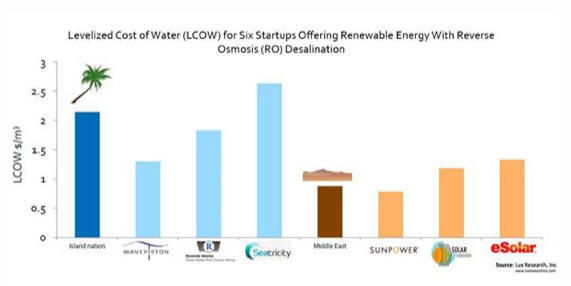 |
| Reviews and Templates for Expression We |
Will Clean-Energy Desalination Be a Game-Changing Water Fix?

Desalination is typically an energy-intensive — and thus expensive — way to produce freshwater, which is one of the reason it has been slow to take off as a widespread solution to water shortages.
This is what makes renewable energy-powered desalination so desirable, and will play a key role in the market’s growth, according to a Lux Research report.
Emerging Green Desalination: Solar and Wave Technologies, says desalination will grow to 140 million cubic meters in 2020, reflecting soaring demand for freshwater and growing viability of renewable energy technologies such as solar and wind.
“There is an opportunity in the tens of billions of dollars for renewable energy in desalination, Lux Research analyst and report author Thomas Ooi told Environmental Leader. “The process is energy-intensive and current world production consumes more than 200 million kWh per day, none of which is renewable. We estimate global desalination capacity to reach about 140 million cubic meters per day by 2020 at a conservative 8 percent growth.”
For example, demand for potable water in the Middle East is 203 billion cubic meters per year, and islands in the Caribbean and Oceania add 80 billion cubic meters, the report says. These regions can be prime targets for so-called green desalination with energy sources like solar and wave power.
“Forward osmosis, coupled with thermal solar, is another promising technology that can challenge incumbent photovoltaic solar and reverse osmosis,” Ooi said.
Traditional desalination uses reverse osmosis (RO), which purifies water by pushing it under high pressure through a semipermeable membrane. Forward osmosis (FO) also employs a semipermeable membrane, but uses a “draw” solution, not hydraulic pressure, which requires significantly less energy.
Lux Research evaluated solar and wave power for desalination and six startups that offer innovative desalination technologies. Among the findings:
- SunPower leads among solar firms for green desalination. SunPower’s solar panels require the least land – 0.8 km2 for a typical plant that produces 540,000 m3 of freshwater daily. In comparison, eSolar needs 2.4 km2 and Solar Euromed’s system takes up 3.6 km2. SunPower’s PV technology powering RO achieves a cost of $0.78/m3.
- Wavepiston leads in cost. Among wave energy startups, Wavepiston has the lowest levelized cost of water (LCOW) of $1.30/m3 while Resolute Marine Energy (RME) was second with $1.83/m3.
- Seatricity leads in commercial development. Seatricity is far ahead in commercial development than most wave energy developers, having weathered field trials in Scotland’s winter storms with waves as high as 15 meters.
“Seatricity has deployed its 162 kW Oceanus 2 16 km offshore at WaveHub in Cornwall, UK,” Ooi said. “This is a full-sized wave energy converter. The success of Oceanus 2 will lead to a 60-unit wave farm in Cornwall, generating up to 10 MW for 10,000 homes.”
While there are no commercial wave desalination plants in the US, Ooi says he’s keeping an eye on WaterFX, which is building the country’s largest solar desalination plant in Fresno, California this year. This desalination project utilizes multiple effect distillation (MED), which is a different process from reverse osmosis or forward osmosis. MED units evaporate source water in one or more stages, or “effects,” to produce potable water. This is also a low-energy-use process as each stage reuses the energy from the previous one.
WaterFX’s desalination project uses this distillation process to turn agriculture wastewater into freshwater and thermal solar as its energy source.
Late late year the largest seawater desalination facility in the US came online in northern San Diego County. The $1 billion Carlsbad Desalination Plant, owned and developed by Poseidon Water, can produce up to 56,000 acre-feet of water per year.
As drought intensifies is many places globally, and renewable energy becomes more cost effective, clean-energy powered desalination looks like an increasingly attractive technology to produce freshwater from a low- or no-carbon energy source. And deep pockets are working to make it happen.
|
|
|
|
Copyright remains with the original authors |